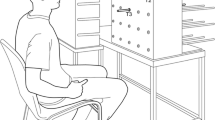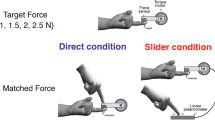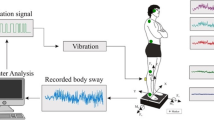Abstract
Parkinson’s disease preferentially affects internally generated movements, e.g., movements recalled from memory, while externally cued movements are relatively preserved. However, l-dopa may have effects on visually guided movements as well as error-related processing. Fourteen Parkinson’s disease (PD) subjects (on and off l-dopa medication) as well as ten normal controls performed a tracking task using a joystick. During discrete 30 s blocks, the visual feedback of the actual tracking errors were attenuated, amplified or unaltered. Second order dynamical system models, with the desired trajectory as the input and the actual motor performance as the output, were used to characterize the motor performance by the each subject under each condition. Although the overall root-mean-square tracking error did not significantly differ between groups, the nature of the motor performance differed significantly across groups. A clear dissociation was made between manipulations of error feedback—which altered the natural frequency of the models—and the effects of l-dopa, which affected damping. Compared to normal controls, PD subjects were significantly overdamped before medication and underdamped after medication. We interpret our results as being suggestive of l-dopa normalization of compensatory overactive cerebellar activity in PD.





Similar content being viewed by others
References
Abdel-Malek A, Marmarelis VZ (1988) Modeling of task-dependent characteristics of human operatordynamics pursuit manual tracking. IEEE Trans Syst Man Cybern 18(1):163–172
Aisen ML (1993) The effect of mechanical damping loads on disabling action tremor. Neurology 43(7):1346–1350
Bayliss JD, Ballard DH (2000) Recognizing evoked potentials in a virtual environment. Advances in Neural Information Processing Systems, Denver
Calne DB, Snow BJ et al (1992) Criteria for diagnosing Parkinson’s disease. Ann Neurol 32:S125–S127
Cheng S, Sabes P (2006) Modeling sensorimotor learning with linear dynamical systems. MIT Press 18:760–793
Fahn S (2003) Description of Parkinson’s disease as a clinical syndrome. Ann N Y Acad Sci 991:1–14
Frank MJ (2005) Dynamic dopamine modulation in the basal ganglia: a neurocomputational account of cognitive deficits in medicated and nonmedicated Parkinsonism. J Cogn Neurosci 17(1):51–72
Frank MJ, Seeberger LC et al (2004) By Carrot or by Stick: cognitive reinforcement learning in Parkinsonism. Am Assoc Adv Sci 306:1940–1943
Georgiou N, Iansek R et al (1993) An evaluation of the role of internal cues in the pathogenesis of parkinsonian hypokinesia. Brain 116(Pt 6):1575–1587
Glickstein M, Stein J (1991) Paradoxical movement in Parkinson’s disease. Trends Neurosci 14(11):480–482
Hoehn MM, Yahr MD (1967) Parkinsonism: onset, progression and mortality. Neurology 17(5):427–442
Holroyd CB, Coles MGH (2002) The neural basis of human error processing: reinforcement learning, dopamine, and the error-related negativity. Psychol Rev 109(4):679–709
Johnson MTV, Mendez A et al (1994) Acute effects of levodopa on wrist movement in Parkinson’s disease. Kinematics, volitional EMG modulation and reflex amplitude modulation. Brain 117(Pt 6):1409–1422
Johnson MTV, Kipnis AN et al (1996) Effects of levodopa and viscosity on the velocity and accuracy of visually guided tracking in Parkinson’s disease. Brain 119(3):801
Jueptner M, Weiller C (1998) A review of differences between basal ganglia and cerebellar control of movements as revealed by functional imaging studies. Brain 121:1437–1449
Jueptner J, Jueptner M et al (1996) The sensory guidance of movement: a comparison of the cerebellum and basal ganglia. Exp Brain Res 112(3):462–474
Lemieux S, Ghassemi M et al (2007) The influence of levodopa-induced dyskinesias on manual tracking in patients with Parkinson’s disease. Exp Brain Res 176(3):465–475
Lewis GN, Byblow WD et al (2000) Stride length regulation in Parkinson’s disease: the use of extrinsic, visual cues. Brain 123(Pt 10):2077–2090
Lewis M, Slagle C et al (2007) Task specific influences of Parkinson’s disease on the striato-thalamo-cortical and cerebello-thalamo-cortical motor circuitries. Neurosci Lett 147(1):224–235
Liu X, Tubbesing SA et al (1999) Effects of visual feedback on manual tracking and action tremor in Parkinson’s disease. Exp Brain Res 129(3):477–481
Ljung L (1999) System identification: theory for the user. Upper Saddle River, NJ., Prentice Hall
MacMillan ML, Dostrovsky JO et al (2004) Involvement of human thalamic neurons in internally and externally generated movements. Am Physiol Soc 91:1085–1090
Morrice BL, Becker WJ et al (1990) Manual tracking performance in patients with cerebellar incoordination: effects of mechanical loading. Can J Neurol Sci 17(3):275–285
Mushiake H, Strick PL (1993) Preferential activity of dentate neurons during limb movements guided by vision. J Neurophysiol 70(6):2660–2664
Oliveira RM, Gurd JM et al (1997) Micrographia in Parkinson’s disease: the effect of providing external cues. J Neurol Neurosurg Psychiatry 63(4):429–433
Paquet F, Bedard MA et al (2008) Sensorimotor adaptation in Parkinson’s disease: evidence for a dopamine dependent remapping disturbance. Exp Brain Res 185(2):227–236
Rottach KG, Riley DE, DiScenna AO, Zivotofsky AZ, Leigh RJ (1996) Dynamic properties of horizontal and vertical eye movements in parkinsonian syndromes. Ann Neurol 39(3):368–377
Sabatini U, Boulanouar K et al (2000) Cortical motor reorganization in akinetic patients with Parkinson’s disease: a functional MRI study. Brain 123(Pt 2):394–403
Schlesinger I, Erikh I et al (2007) Paradoxical kinesia at war. Mov Disord 22:2394–2397
Stein J, Aziz T (1999) Does imbalance between basal ganglia and cerebellar outputs cause movement disorders? Curr Opin Neurol 12(6):667
Thobois S, Ballanger B et al (2007) Functional anatomy of motor urgency. Neuroimage 37(1):243–252
Uc EY, Rizzo M, Anderson SW, Qian S, Rodnitzky RL, Dawson JD (2005) Visual dysfunction in Parkinson disease without dementia. Neurology 65:1097–1913
Vaillancourt DE, Thulborn KR et al (2003) Neural basis for the processes that underlie visually guided and internally guided force control in humans. J Neurophysiol 90(5):3330–3340
Wenzelburger R, Zhang B-R et al (2002) Force overflow and levodopa-induced dyskinesias in Parkinson’s disease. Brain 125(Pt 4):871–879
Yu H, Sternad D et al (2007) Role of hyperactive cerebellum and motor cortex in Parkinson’s disease. Neuroimage 35(1):222–233
Acknowledgments
The study was supported by the Pacific Parkinson’s Research Centre, a Team Grant from the Canadian Institutes of Health Research and the National Parkinson Foundation (Miami, USA) and a Collaborative Health Research Grant (CHRP 323602-06) to Dr. McKeown. Dr Wing-Lok Au was supported by research fellowships from the National Healthcare Group and the National Medical Research Council, Singapore.
Author information
Authors and Affiliations
Corresponding author
Electronic supplementary material
Rights and permissions
About this article
Cite this article
Au, WL., Lei, N., Oishi, M.M.K. et al. l-Dopa induces under-damped visually guided motor responses in Parkinson’s disease. Exp Brain Res 202, 553–559 (2010). https://doi.org/10.1007/s00221-010-2156-z
Received:
Accepted:
Published:
Issue Date:
DOI: https://doi.org/10.1007/s00221-010-2156-z




